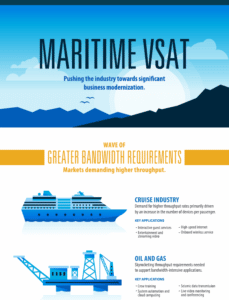
The maritime market is growing at rapid pace, and today we’re seeing two distinct forms of adoption. Some segments are ready to embrace VSAT on a larger scale in response to improved economics and broader application, while other segments are demanding faster throughput levels for increasingly higher traffic networks.
Check out this maritime VSAT infographic to explore the latest growth trends in the commercial, cruise, fishing, and oil and gas segments. And read on below for an expanded market overview.
Commercial
According to NSR, the trend in commercial shipping involves ships that are “bigger, yet better.” In other words, more shipping fleets using fewer ships, opting to increase the freight per ship. This is a trend that is likely to continue as a means of keeping CAPEX low, especially as crude oil prices stay low.
Still, commercial remains the largest growing segment, growing from only 6,900 VSAT-equipped vessels in 2016 to more than 25,100 by 2026 — a 12.4 percent CAGR. Some of the world’s largest container fleets and freight companies are deploying VSAT, having seen the value VSAT has delivered to early adopters. Key applications for growth will be crew welfare, electronic charting and weather, remote IT services and electronic port and customs documentation.
Cruise
Cruise is another segment that has relied on VSAT for many years and now demands continually higher data rates. As traffic demands surge and the number of devices per passenger per ship increases, cruise liners are upgrading their VSAT networks to support higher-speed Internet, onboard wireless service, entertainment and streaming video.
According to NSR, superyacht and general leisure markets remain strong, with new ship orders demanding higher bandwidth options. Passenger markets are poised to move over to HTS-based offerings in GEO and Non-GEO, with almost 47 Gbps of demand by 2026, in addition to 79 TPEs of FSS capacity. HTS services are predicated to drive significant adoption with better coverage, more affordable bandwidth and lower-cost equipment.
Fishing
Fishing is a segment where the addressable market is growing steadily. The expectation is that regulatory pressure on fleet, combined with smaller terminals and better pricing, will drive the market. In fact, it is anticipated that the fishing segment will experience a CAGR of 8 percent for VSAT-equipped vessels by 2026 — the second highest amongst the four segments measured by NSR.
Historically, fishing has been a tough market to crack as most fishing vessels remain within cellular coverage or simply are not away from land long enough to justify the investment in VSAT. Despite this fact, the market could grow based on new applications that bring commerce onboard. For example, VSAT connectivity could drive online sales of catches and auctions, and be leveraged for regulatory reporting, vessel monitoring and telemedicine.
Oil Rigs
Downtime on an oil rig comes at an exorbitant cost, so the value proposition for VSAT has never been in question. Energy companies must be able to support bandwidth-intensive applications, such as the use of live video for rig monitoring and remote collaboration, and the transfer of heavy data files, such as seismic data. And then there’s asset tracking, crew training, systems automation and cloud computing.
That said, offshore operations are feeling the pressure of reduced crude oil prices, stacking support vessels and shutting down rigs. The way forward involves cutting CAPEX, scaling back programs and seeking more “bang-for-the-buck” services, NSR says. This highly penetrated market for VSAT is set to be the slowest growing of all segments, moving from 2,400 in service vessels in 2016 to 2,500 in 2026 – a 0.4 percent CAGR. The growth story for oil and gas/offshore is the average Mbps per site growth is at 3.5 Mbps in 2016 to 22 Mbps by 2026 – an 18 percent CAGR.
How can operators support an ever-growing list of applications as global deployments become more and more expansive? Learn more in this new maritime report, Navigating New Waters: How to Leverage VSAT Innovation to Meet Growing Customer Needs.